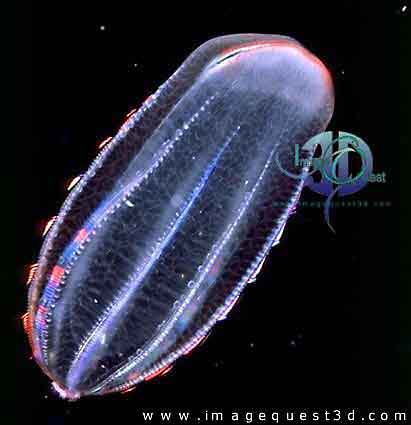|
Comb
Jelly (Beroe)
©
2000 by Image Quest 3-D
Read our copyright notice
Photograph by Peter Parks Ctenophores (Phylum Ctenophora), also known as comb jellies, are a remarkable and distinctive group of gelatinous predators. At times planktonic, comb jellies can be very abundant and ecologically important, inhabiting many marine habitats, from coastal surface waters to the ocean depths. Comb jellies are unique in having eight rows of ciliated plates (the comb rows) which are used for locomotion. With shimmering, irridescent rainbow patterns formed by the diffraction of light from the comb plates, ctenophores are often thought of as some of the most beautiful creatures in the sea. Although ctenophores resemble cnidarian jellies in that they are carnivorous, often transparent and have a gelatinous consistancy, they are not closely related and lack the alternation of polyp and medusa generations found in most pelagic cnidarians. Beroe (Order Beroida) has a body resembling a sac, lacking tentacles or lobes at the oral end. Beroe are highly predatious and swim nearly all of the time in search of prey, leading with the mouth which is normally closed in order to maintain a streamlined profile (see above). The mouth opens to swallow prey directly, or can 'bite' pieces of prey too large to swallow by using the macrocilia that line the upper region of the pharynx. Click here to view more images of Beroe - including images of Beroe attacking a fellow comb jelly, Mnemiopsis. Click here to view the 'Picture of
the Week' archive.
|
||||||||
|
|
||||||||


